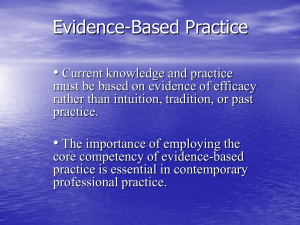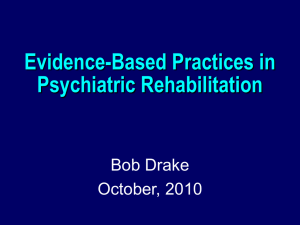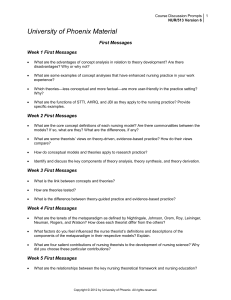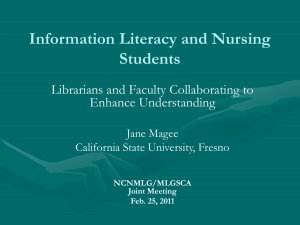Domain I - Association of Rehabilitation Nurses
advertisement
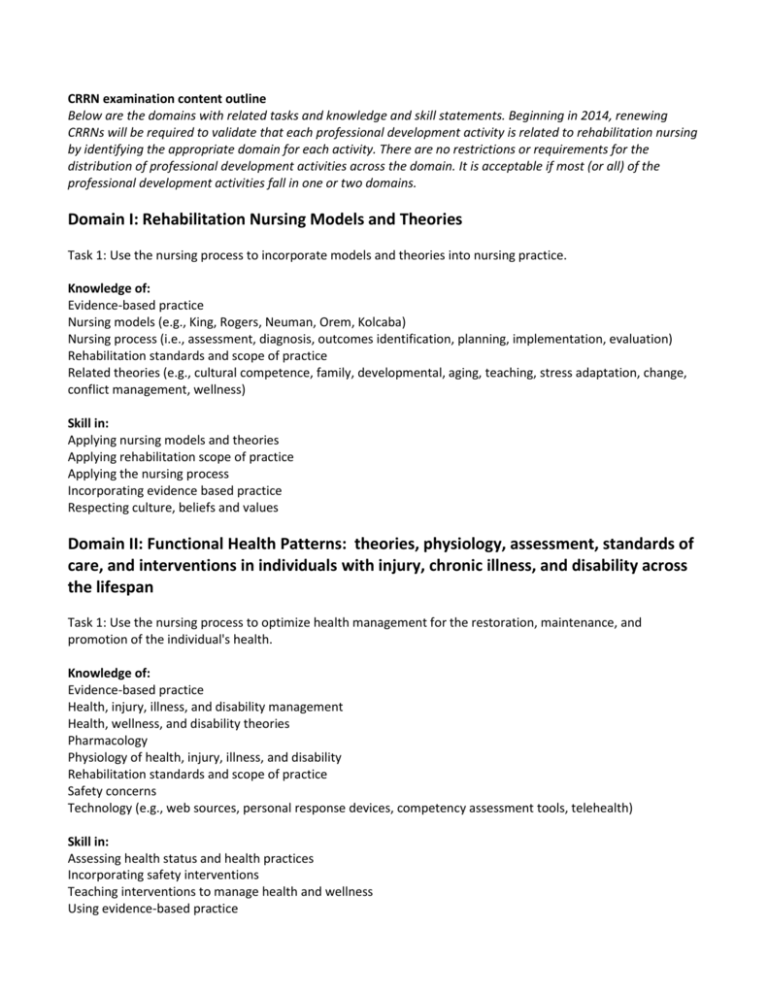
CRRN examination content outline Below are the domains with related tasks and knowledge and skill statements. Beginning in 2014, renewing CRRNs will be required to validate that each professional development activity is related to rehabilitation nursing by identifying the appropriate domain for each activity. There are no restrictions or requirements for the distribution of professional development activities across the domain. It is acceptable if most (or all) of the professional development activities fall in one or two domains. Domain I: Rehabilitation Nursing Models and Theories Task 1: Use the nursing process to incorporate models and theories into nursing practice. Knowledge of: Evidence-based practice Nursing models (e.g., King, Rogers, Neuman, Orem, Kolcaba) Nursing process (i.e., assessment, diagnosis, outcomes identification, planning, implementation, evaluation) Rehabilitation standards and scope of practice Related theories (e.g., cultural competence, family, developmental, aging, teaching, stress adaptation, change, conflict management, wellness) Skill in: Applying nursing models and theories Applying rehabilitation scope of practice Applying the nursing process Incorporating evidence based practice Respecting culture, beliefs and values Domain II: Functional Health Patterns: theories, physiology, assessment, standards of care, and interventions in individuals with injury, chronic illness, and disability across the lifespan Task 1: Use the nursing process to optimize health management for the restoration, maintenance, and promotion of the individual's health. Knowledge of: Evidence-based practice Health, injury, illness, and disability management Health, wellness, and disability theories Pharmacology Physiology of health, injury, illness, and disability Rehabilitation standards and scope of practice Safety concerns Technology (e.g., web sources, personal response devices, competency assessment tools, telehealth) Skill in: Assessing health status and health practices Incorporating safety interventions Teaching interventions to manage health and wellness Using evidence-based practice Using rehabilitation standards and scope of practice Using technology Task 2: Use the nursing process to promote the individual's optimal nutritional and metabolic patterns. Knowledge of: Adaptive equipment Anatomy and physiology related to nutritional and metabolic patterns (e.g., endocrine, obesity, swallowing, skin integrity) Diagnostic testing Evidence-based practice Feeding techniques (e.g., positioning, food and fluid consistency) Fluid volume Nutritional needs Pharmacology (e.g., antispasmodics, anticholinergics, analgesics) Safety concerns and interventions (e.g., swallowing, positioning) Skill in: Assessing nutritional and metabolic patterns Implementing and evaluating interventions for nutritional intake, fluid volume deficits, skin integrity, metabolic functions, swallowing ability, and eating Teaching interventions for skin integrity (e.g., breakdown, pressure relief, hydration) Teaching interventions for swallowing concerns (e.g., aspiration, chewing, choking) Teaching interventions to manage nutrition and metabolic problems Using adaptive equipment appropriately Using evidence-based practice in care planning process Task 3: Use the nursing process to establish the individual's elimination patterns. Knowledge of: Anatomy and physiology of bladder and bowel (e.g., types of altered continence: constipation, diarrhea, incontinence, retention) Autonomic dysreflexia Bladder and bowel resources and technology (e.g., bladder scan, competency assessment tools, supplies, adaptive equipment) Bladder and bowel training (e.g., incontinence, retention, ostomies, catheters) Evidence-based practice Pharmacology Skill in: Assessing elimination patterns Implementing and evaluating interventions for bladder and bowel management Recognizing stages of grief and loss of bodily functions Teaching interventions for autonomic dysreflexia Teaching interventions for bowel and bladder management Teaching use of adaptive equipment Using evidence-based practice Using medications Using technology Task 4: Use the nursing process to promote the individual's optimal activity and exercise patterns. Knowledge of: Anatomy and physiology of musculoskeletal, respiratory, and cardiovascular function Assistive devices and technology (e.g., mobility aids, vital sign assessment, alarms) Clinical signs of disrupted sensory and motor function Evidence-based practice Interventions related to musculoskeletal, respiratory, and cardiovascular function Management of activity tolerance Pharmacology Safety concerns (e.g., falls, burns) Self-care activities and activities of daily living Skill in: Assessing pain Assessing safety risks Assessing self-care ability and mobility Assessing specific motor impairments (e.g., spasticity, paralysis, tremor, flaccidity, endurance, energy, balance, strength, contractures) Implementing and evaluating interventions for cardiovascular and respiratory impairments Implementing and evaluating interventions for motor and sensory impairments Implementing and evaluating interventions for self-care ability Implementing and evaluating interventions to prevent musculoskeletal complications (e.g., contractures, heterotrophic ossification) Implementing interventions for safety (e.g., sitters, reorientation, environment, diversion, chemical and physical restraints) Using evidence-based practice Using technology (e.g., mobility aids, pressure relief devices, informatics, assistive software) Task 5: Use the nursing process to promote the individual's optimal sleep and rest patterns. Knowledge in: Evidence-based practice Factors affecting sleep and rest (e.g., diet, sleep habits, alcohol, pain, and environment) Pharmacology Physiology of sleep and rest cycles Technology Skill in: Assessing sleep and rest patterns Evaluating effectiveness of sleep and rest interventions Teaching interventions and strategies to promote sleep and rest Using evidence-based practice Using technology (e.g., c-pap, bi-pap, relaxation technology) Task 6: Use the nursing process to promote the individual's optimal cognitive and perceptual patterns. Knowledge of: Evidence-based practice Measurement tools (e.g., Rancho, Glasgow, Mini Mental Exam, pain analog scales) Neuroanatomy and physiology (e.g., cognition, judgment, sensation, perception) Pain (e.g., receptors, acute, chronic, theories) Pharmacology Safety concerns Technology Skill in: Assessing cognition, perception, sensation, apraxia, perseveration, and pain Implementing and evaluating strategies for safety (e.g., personal response devices, alarms) Teaching strategies for neurological deficits Teaching strategies for pain and comfort management (e.g., positioning, ice, heat) Using technology (e.g., TENS unit) Task 7: Use the nursing process to promote the individual’s optimal self-perception and self-concept pattern. Knowledge of: Body image Evidence-based practice Self-esteem Self-perception and self-concept theories (e.g., powerlessness, hopelessness, helplessness, stress, unsolved grief) Stages of grief and loss Skill in: Assessing self-perception and self-concept Accessing supportive team resources (e.g., psychologist, clergy, peer support) Implementing and evaluating strategies to promote self-worth (e.g., role playing, positive affirmation) Promoting positive self-image Using evidence-based practice Task 8: Use the nursing process to optimize individual role and relationship patterns. Knowledge of: Evidence-based practice Individual roles and relationships (e.g., cultural, environmental, societal, familial, gender, age) Role alterations Theories (e.g., role, relationship, interaction, developmental, human behaviors) Skill in: Assessing change in roles and relationship Facilitating appropriate resources and services Including the individual and family or caregiver in the plan of care Incorporating cultural and spiritual values Promoting positive interaction among individual and family or caregivers Promoting strategies to cope with changes in roles and relationships (e.g., individual and family counseling, peer support, education) Using evidence-based practice Task 9: Use the nursing process to promote the individual's optimal sexuality and reproductive function. Knowledge of: Adaptations and modifications (e.g., body positioning, PLISSIT model, pharmacology, technology) Alterations in sexual function and reproduction Anatomy and physiology of sexual response and reproduction Autonomic dysreflexia (e.g., labor and delivery, bowel, and bladder) Evidence-based practice Factors that can affect sexual relationships and sexuality (e.g., human behaviors, pharmacology, illness, developmental stages, cultural preferences) Skill in: Assessing changes in sexual function and reproduction Teaching interventions and technology (e.g., body positioning, mirrors, adaptive equipment, medication, reproduction) Teaching safety issues related to sexuality and reproduction (e.g., autonomic dysreflexia, STDs, abuse, and pregnancy) Using evidence-based practice Task 10: Use the nursing process to facilitate coping and stress management. Knowledge of: Community resources (e.g., face-to-face support groups, Internet, respite care, clergy) Coping and stress management strategies for individuals and family systems Cultural competence Evidence-based practice Physiology of the stress response Psychosocial adaptation Safety concerns (e.g., harm to self and others) Supporting spirituality and coping Technology (e.g., biofeedback) Theories (e.g., developmental, coping, stress, grief and loss, self-esteem, self-concept) Types of stress and stressors for an individual or situation Skill in: Assessing potential for harm to self and others Assessing the ability to cope and manage stress Facilitating appropriate referrals Implementing and evaluating strategies to relieve stress and enhance coping (e.g., pharmacology, technology, alternative and complementary medicine) Using effective communication (e.g., active listening) Using evidence-based practice Task 11: Use the nursing process to support the culture, values, beliefs, and spiritual systems to achieve holistic wellness. Knowledge of: Alternative modalities (e.g., biofeedback, hypnotherapy, acupuncture, botanicals, faith healer) Belief systems and values Community and organizational resources Cultural competence Evidence-based practice Factors influencing spirituality Technology Traditional modalities (e.g., spirituality, medications, psychosocial therapy) Skill in: Assessing values, belief systems, and spirituality and their impact on the individual Implementing and evaluating strategies to support holistic wellness Making appropriate referrals Supporting beliefs and values Using culturally competent interventions Using evidence-based practice Task 12: Use the nursing process to facilitate the individual's effective communication. Knowledge of: Anatomy and physiology (e.g., cognition, comprehension, sensory deficits) Communication techniques and equipment Cultural competence Developmental factors Evidence-based practice Linguistic deficits (e.g., aphasia, dysarthria) Patterns of recovery Verbal and nonverbal communication Skill in: Assessing comprehension and communication (e.g., oral, written, auditory, and visual) Creating a safe and therapeutic environment Implementing and evaluating communication interventions Involving support systems Respecting cultural differences Using adaptive technology Using effective communication skills Using evidence-based practice Domain III: The Function of the Rehabilitation Team and Community Re-entry Task 1: Collaborate with the interdisciplinary team to achieve and maintain the individual's highest level of independence and optimal health. Knowledge of: Expected outcomes and individual goals Healthcare teams (e.g., multidisciplinary, interdisciplinary, transdisciplinary) Rehabilitation philosophy and definition Roles and responsibilities of team members Theory (e.g., change, leadership, conflict, team function, organizational) Skill in: Applying appropriate theories Collaborating with the healthcare team Communicating effectively Developing and documenting plan of care Incorporating appropriate team members Task 2: Use the nursing process to promote community re-entry and integration. Knowledge of: Adaptive technology Available community resources (e.g., housing, transportation, support groups, social services) Available personal resources (e.g., financial, family and support systems, caregivers, spiritual, cultural) Available professional resources (e.g., psychologist, neurologist, clergy, teacher, case manager, vocational rehabilitation counselor, home health, outpatient therapy) Evidence-based practice Injury, disability, and chronic illness process and prognosis Teaching and learning strategies Skill in: Accessing community resources Assessing individual readiness and barriers to community living Evaluating outcomes and adjusting goals Incorporating cost considerations Initiating referrals Participating in team and patient family conferences Planning discharge (e.g., home visits, caregiver teaching) Teaching health and wellness maintenance Teaching life skills Using adaptive technology (e.g., voice activated call systems, computer supported prosthetics) Using evidence-based practice Domain IV: Legislative, Economic, Ethical, and Legal Issues Task 1: Integrate legislation and regulations into care management to promote independence. Knowledge of: Regulatory agencies related to disability and rehabilitation (e.g., CARF, JC, APS, CPS, CMS, SSA, OSHA) Specific laws related to disability and rehabilitation (e.g., Medicare, Medicaid, ADA, rehabilitation acts, HIPAA, ADA, Workers Comp) Skill in: Accessing, interpreting, and applying legal, regulatory, staffing, and accreditation information Utilizing assessment, measurement, and reporting tools (e.g., functional ability, patient satisfaction) Task 2: Use the nursing process to deliver cost effective care. Knowledge of: Clinical practice guidelines Community and public resources Insurance and reimbursement (e.g., PPS, Workers Comp) Quality improvement and performance measures Regulatory agency audit process Staffing patterns and policies Standards of professional performance Utilization review processes Skill in: Analyzing quality and utilization data Communicating with private, community, and public resources Documenting specific to regulatory and accreditation agencies Incorporating clinical practice guidelines Incorporating standards of professional performance Managing current and projected resources in a cost effective manner Task 3: Integrate ethical and legal considerations into the nursing process. Knowledge of: Ethical theories and resources (e.g., deontology, ombudsperson, ethics committee) Legal implications of healthcare related policies and documents (e.g., HIPAA, advance directives powers of attorney, informed consent) Skill in: Advocating for the individual Documenting services provided Identifying appropriate resources to assist with completion of legal documents Implementing strategies to resolve ethical dilemmas Providing ethical care

